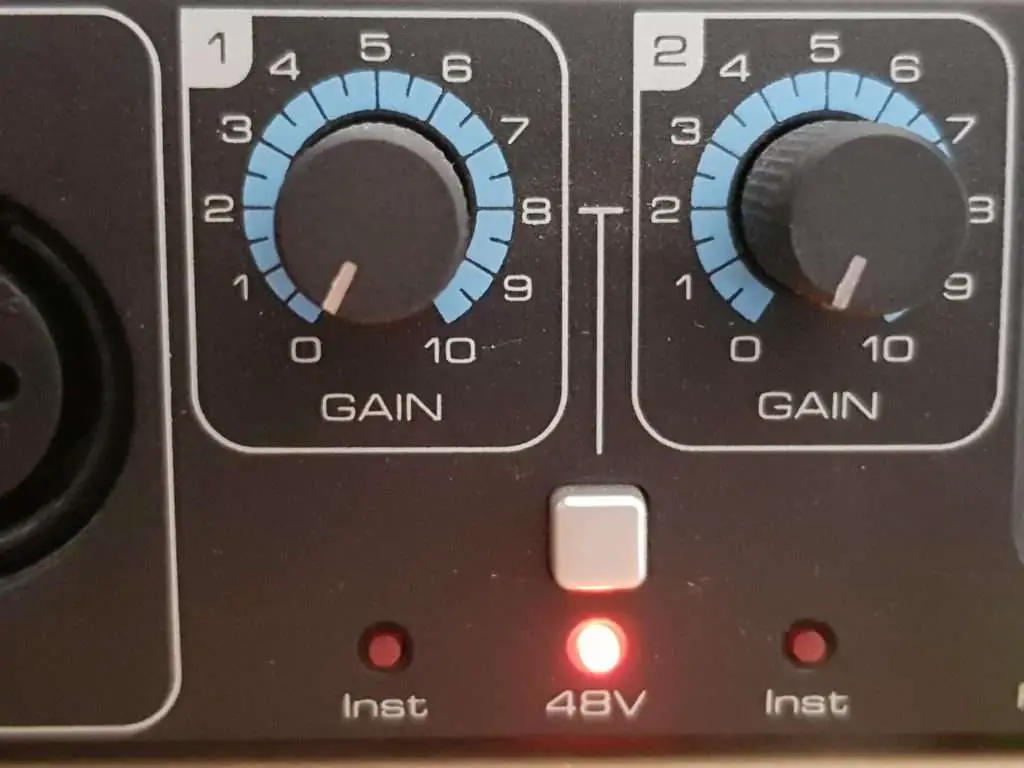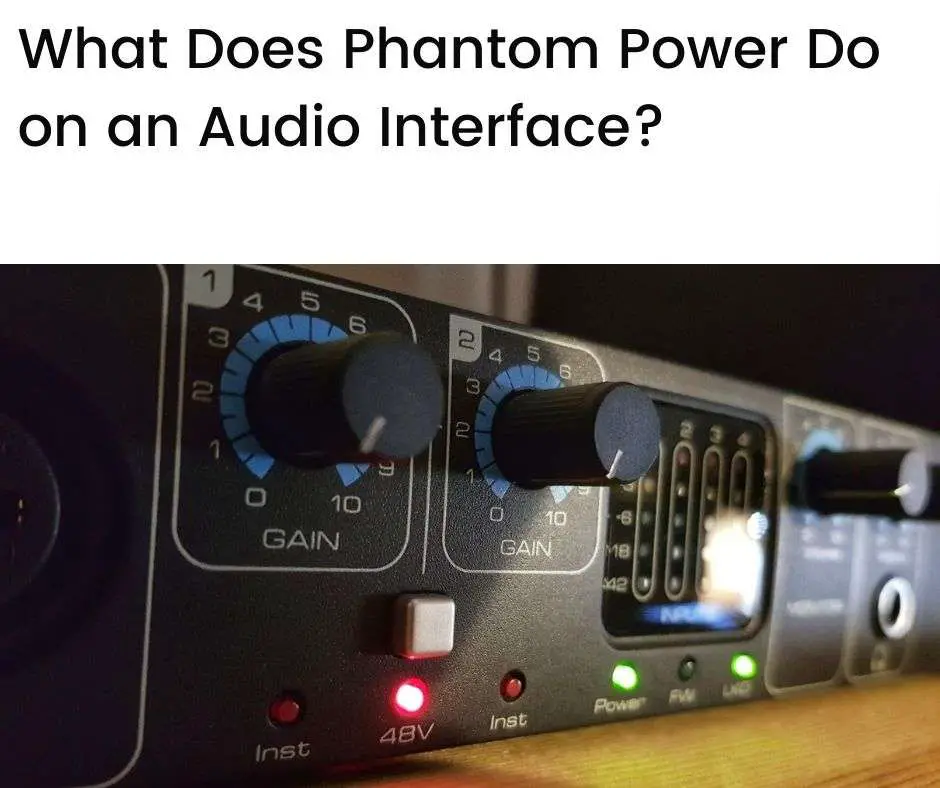Phantom power on an audio interface provides power to active components such as condenser mics. It is delivered through balanced audio cables and can appear to be ‘phantom’ when there’s no visible external power supply. The unique construction and sensitivity of condenser mics mean that they require an additional current to boost their signals, and this is provided by phantom power.
In this article we’ll look at:
- What is phantom power?
- 48v phantom power on audio interfaces
- Why do condenser mics need phantom power?
- Do you need phantom power for ribbon or dynamic mics?
- Conclusion
- FAQs
What is phantom power?
Phantom power on an audio interface refers to a DC current delivered through (balanced) audio cables to provide power for microphones and other equipment.
This type of current is often referred to as ‘phantom‘ when there are no visible external power supply or cables used—the current is delivered directly from an interface to the device requiring the power through a balanced audio cable.
A balanced audio cable uses three conductors—two for carrying balanced signals (positive and negative) and a third for ground. An XLR cable, used for connecting condenser microphones to audio interfaces, is an example of a balanced audio cable.
Another reason for the term phantom is that when the same voltage is applied to the two signal-carrying conductors of a balanced cable (relative to ground), there’s no voltage difference between them. Hence, any power delivered through the cable appears to be ‘phantom’.
Phantom power is used for microphones that have active circuitry (i.e., circuits designed to operate with an external current), such as condenser microphones.
48v phantom power on audio interfaces
Many audio interfaces have a button labeled ’48V’ (or sometimes ‘P48’)—this is the phantom power switch.

The 48V refers to a voltage of 48 volts that’s applied to the signal-carrying conductors of a connected XLR (balanced) audio cable.
Phantom power can run on 12 to 48 volts, but the audio industry standard is 48 volts.
When connecting a condenser mic to an audio interface, pressing the 48V button activates phantom power and provides a current through the connected balanced audio cable. Most audio engineers advise that you activate phantom power after plugging in a cable (with an attached mic).
Without phantom power, a connected condenser mic won’t operate. If phantom power isn’t available on your audio interface, you’ll need to find another source of phantom power, such as an external power supply, to power your condenser mic.
Why do condenser mics need phantom power?
Condenser mics are the microphones of choice for most recording studios. They offer higher sensitivity and fidelity compared to other microphones, such as ribbon or dynamic mics.
Microphones, in essence, convert sound waves to electrical signals, and different types of microphones have different ways of doing this. In the case of condenser mics, an electric current—i.e., phantom power—is required.
To understand why condenser mics need phantom power, let’s look at how they’re made and how they work.
How condenser mics are made
Condenser mics work through the principle of electrical capacitance—the ability to store electrical energy between two conducting surfaces.
One of the conducting surfaces used in a condenser mic is usually a solid metal plate and the other is a thin membrane called a diaphragm.
The diaphragm is made from a thin polyester film, or mylar, which is covered by a thin layer of gold.
The gold is applied by a technique called sputtering (i.e., applying a molecular layer of atoms to a surface), so the diaphragms used in condenser mics are often referred to as gold-sputtered mylar.
How condenser mics work
In an electrical capacitor, the distance between the conducting surfaces determines the amount of capacitance produced. If the distance changes, the capacitance also changes.
This phenomenon is exploited by condenser mics.
As sound waves hit a condenser mic’s diaphragm, its distance from the solid plate changes in sync with the sound waves. This results in changes to capacitance, which creates an electrical signal that mimics the sound waves.
The diaphragms of condenser mics are very thin, sometimes only 6 microns thick (0.006 mm), so they are also very fragile. This is why they are very sensitive to quiet sounds and are good at picking up audio nuances in a studio environment.
But the small size and fragility of a condenser mic’s capacitor arrangement mean that only a tiny electrical current is produced. This signal is too small to be connected to any equipment in an audio workflow. A powered circuit is required, therefore, to boost the signal with current.
Phantom power provides the additional current needed to boost the tiny signals generated by condenser mics.
Do you need phantom power for ribbon or dynamic mics?
Ribbon and dynamic mics are constructed differently from condenser mics. They’re more robust and durable, but they’re less sensitive to picking up nuanced sounds and are used less frequently in studio environments.
Unlike condenser mics, dynamic and (most) ribbon mics have only passive circuitry—they do not require an external power supply.
So, you don’t need phantom power for (passive) ribbon and dynamic mics.
If you accidentally switch phantom power on when using a (passive) ribbon or dynamic mic, in most cases it will make no difference. This is yet another reason for the name ‘phantom’ with this type of power—it has no effect on passive electronic devices.
But in some cases, phantom power may add unwanted noise to the audio workflow when using passive devices. It may also damage passive mics if there happens to be an imbalance in the voltage being applied to the microphone cables that connect the mics.
You should, therefore, leave phantom power switched off when using (passive) ribbon or dynamic mics.
Conclusion
Many audio interfaces come with a phantom power (48V) switch.
This is used for connecting audio devices that contain active circuitry, the most common such device being a condenser microphone.
Since phantom power can be delivered by an audio interface without the need for an external power supply, there’s no visible source for the power. It also has no effect when applied to passive electronic devices, such as dynamic mics and some ribbon mics.
This is why this type of power is referred to as phantom.
Phantom power is transmitted from an audio interface through balanced audio cables, such as the XLR cables used to connect microphones. Balanced cables have three conductors—two for connecting positive and negative (balanced) signals, and one for ground.
Condenser mics are designed on the principle of electrical capacitance and are constructed to be sensitive—they can pick up nuanced sounds, and they’re the microphone of choice in studio environments.
They produce only tiny currents, however, and therefore require an additional current—i.e., phantom power—to boost their signal output for interacting with other audio devices.
Other commonly used microphone types—ribbon and dynamic mics—use only passive circuitry and do not require an external power supply. These mics, therefore, do not require phantom power.
FAQs
What is phantom power?
Phantom power is a DC power that’s used to provide power to operate microphones that contain active circuitry. It’s called ‘phantom’ because it’s sent over the same wires that transmit the audio signal and is invisible to the naked eye.
What kind of microphones require phantom power?
Condenser microphones require phantom power. They are very sensitive and pick up faint sounds, but they produce only a small electrical current (audio signal). They need an external power source, therefore, to boost the small signals that they produce.
How much voltage is needed for phantom power?
The most common voltage for phantom power is 48 volts, or ’48V’. This voltage is high enough to boost condenser microphone signals but low enough not to damage the microphones. Some microphones, however, require different voltages, such as 12 or 24 volts. Be sure to check your microphone’s manual to know which voltage it needs.
Do all microphones need phantom power?
No, not all microphones need phantom power. Dynamic microphones and (most) ribbon microphones do not require phantom power. They use a different method to generate an audio signal that does not need an external power source.
How do I turn phantom power on or off?
On an audio interface, there is usually a button or a switch labeled ‘phantom power’ (or ’48V’) that you can turn on or off. When it’s turned on, the interface will send phantom power to a connected XLR cable and microphone. Be sure to turn the phantom power switch off when you’re not using a condenser microphone to avoid damaging it.
Can I use an external power supply instead of phantom power?
Yes, you can use an external power supply, such as a battery pack, to power your condenser microphone. However, you need to make sure that it provides the right voltage and that it’s compatible with your microphone’s connector. Also, keep in mind that external power supplies can be bulky and inconvenient to carry around.







